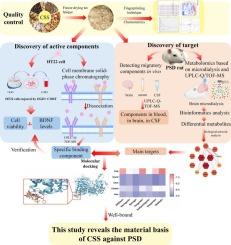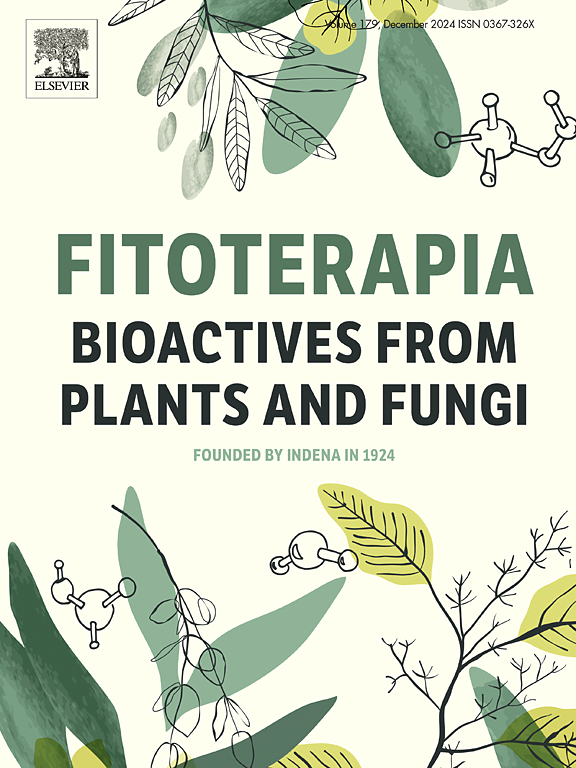结合细胞膜固相色谱和微透析代谢组学研究柴胡疏肝散抗脑卒中后抑郁的物质基础。
IF 2.6
3区 医学
Q3 CHEMISTRY, MEDICINAL
引用次数: 0
摘要
柴胡疏肝散对脑卒中后抑郁有较好的治疗效果,但其药效学物质基础尚不清楚。本研究基于细胞膜固相色谱和海马代谢组学揭示了CSS抗PSD的药效学物质基础。因此,我们采用细胞膜固相色谱结合超高效液相色谱-四极杆飞行时间质谱(UPLC-Q-TOF-MS)技术筛选CSS和HT22细胞的特异性结合成分,并评估其对HT22损伤细胞活力和脑源性神经营养因子(BDNF)的影响。结合脑微透析技术和UPLC-Q-TOF-MS对CSS干预的PSD大鼠海马进行代谢组学研究,构建生物网络揭示CSS抗PSD的作用机制,并进行分子对接评估HT22特异性结合组分与靶蛋白的结合能力。结果表明,通过细胞膜固相色谱法鉴定出8种CSS和HT22细胞的特异性结合成分。除Nobiletin外,其余7种成分均能保护HT22细胞,显著提高BDNF水平。UPLC-Q-TOF-MS技术鉴定出代谢组学中13种差异代谢物。生物网络分析显示,谷胱甘肽代谢可能是CSS抗psd的重要途径。HT22的特异性结合成分与靶蛋白结合良好。本文章由计算机程序翻译,如有差异,请以英文原文为准。

Combined cell membrane solid-phase chromatography and microdialysis-based metabolomics to explore the material basis of Chaihu Shugan San against post-stroke depression
Chaihu Shugan San (CSS) has a good therapeutic effect on post-stroke depression (PSD), but its pharmacodynamic material basis is still unclear. This study revealed the pharmacodynamic material basis of CSS against PSD based on cell membrane solid-phase chromatography and hippocampal metabolomics. Therefore, the specific binding components of CSS and HT22 cells were screened by cell membrane solid-phase chromatography combined with ultra-performance liquid chromatography-quadrupole-time of flight-mass spectrometry (UPLC-Q-TOF-MS) technique, and their effects on the viability and brain-derived neurotrophic factor (BDNF) of injured HT22 cells were evaluated. Conduct metabolomics on the hippocampus of PSD rats with the intervention of CSS combining the brain microdialysis technique and UPLC-Q-TOF-MS, and biological networks were constructed to reveal the mechanism of action of CSS anti-PSD, and molecular docking was performed to evaluate the binding ability of HT22 specific binding components to target proteins. The results showed that 8 specific binding components of CSS and HT22 cells were identified by cell membrane solid-phase chromatography. Except for Nobiletin, the other 7 components could protect HT22 cells and significantly increase BDNF levels. The UPLC-Q-TOF-MS technique identified 13 differential metabolites in metabolomics. Biological network analysis revealed that glutathione metabolism might be an important pathway for CSS anti-PSD. The specific binding component of HT22 was well-bound to the target protein.
求助全文
通过发布文献求助,成功后即可免费获取论文全文。
去求助
来源期刊

Fitoterapia
医学-药学
CiteScore
5.80
自引率
2.90%
发文量
198
审稿时长
1.5 months
期刊介绍:
Fitoterapia is a Journal dedicated to medicinal plants and to bioactive natural products of plant origin. It publishes original contributions in seven major areas:
1. Characterization of active ingredients of medicinal plants
2. Development of standardization method for bioactive plant extracts and natural products
3. Identification of bioactivity in plant extracts
4. Identification of targets and mechanism of activity of plant extracts
5. Production and genomic characterization of medicinal plants biomass
6. Chemistry and biochemistry of bioactive natural products of plant origin
7. Critical reviews of the historical, clinical and legal status of medicinal plants, and accounts on topical issues.
 求助内容:
求助内容: 应助结果提醒方式:
应助结果提醒方式:


